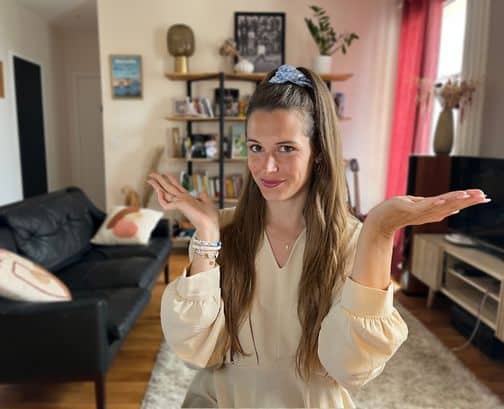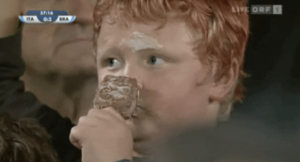In this video, I talk about the expressions used in France when you are in a restaurant. If you liked the video, don't hesitate to like it and subscribe to the channel, it encourages me a lot ! Thanks
- 0:00 - Introduction
- 1:06 - Breakfast / lunch / dinner
- 2:25 - Settling in to the restaurant
- 3:15 - The aperitif
- 3:55 - Difference card / slate
- 4:55 - Menu or dish à la carte
- 5:40 - Place an order
- 7:07 - Cooking meats in French
- 7:45 - Drinking in restaurants (wines, etc.)
- 8:49 - Water (in carafe or bottle)
- 10:02 - Ask for salt or pepper
- 11:10 - The end of the dishes
- 11:40 - The desserts
- 12:35 - The bill
- 13:13 - Tipping in France
- 13:40 - Conclusion and thank you 🙂
📘Feel free to like the video and ask any questions or comments in comments!
TRANSCRIPT OF THE VIDEO
Hello to all of you. I hope you are well, that you are having a good summer and that your French learning is going well. So today, we are going to talk about the restaurant. The restaurant is a must if you come to France. It is therefore essential to learn vocabulary and expressions that will be useful in French once you are in a restaurant in France or in a country where French is spoken. Before you start, remember to activate the subtitles just below.
This will help you understand the video better. To see more videos, think of subscribing to the HelloFrench channel. So first of all, we are going to make a little reminder of the different meals in France, so the different times when we eat during the day. There are three meals in France. The first one is the breakfast. This is the meal we have in the morning. At noon, we call it lunch. In the evening, we call it dinner.
There may also be a fourth meal between lunch and dinner, which is called the snack or "four o'clock". Generally, this is more of a meal time for children. We'll eat something sweet, but as an adult, you can also have a snack or a four-hour meal, if you wish. Now let's get to the heart of the matter. When you walk into a restaurant, you should ask if there is room for you.
You can say "Hi, do you have a table for two for dinner? Or "Hi, there are three of us for lunch. Is there room?" You can also say "Hi, do you have a table for two?" The server may ask if you have a reservation. So, if you called ahead to reserve a table, he or she may say, "Do you have a reservation?" or "Do you have a reservation?" If you have a reservation, you can answer "Yes, I have a reservation under - your name -".
So, for example, I could say "Yes, I have a reservation for four people in the name of Elisabeth". When you enter the restaurant, if you have a reservation, you can directly say "Hello, I have a reservation for two people in the name of - with your name - . So again, I could say when entering a restaurant "Hello, I have a reservation for two people under the name of Elisabeth". Once you are seated, the waiter or waitress, that is to say the person who takes care of you in the restaurant, may ask you if you would like an aperitif.
This is done a lot, especially at dinner time. An aperitif is a drink, alcoholic or not, that you will drink while waiting for the dishes, while the dishes are being prepared, being cooked. The waiter will ask you "Would you like an aperitif?" or "Would you like to have an aperitif?" This can be a cocktail, a juice, an alcohol. If you don't want an appetizer, you can simply answer "no thank you, that's nice" or simply "no thank you".
The waiter will then bring you the menu with the different dishes offered in the restaurants. In France, there is either the menu or what is called a slate. Sometimes, there is also both. So the menu is really like a book with all the dishes inside and the drinks that are proposed by the restaurant and the slate is a blackboard that will be displayed or that moves, where dishes will generally be written with chalk. For example, some restaurants where the dishes change every day, it will be easier for the restaurant to use a slate rather than a printed menu. Sometimes, even if there is a menu, there can also be a slate to indicate the daily specials or the specialties of the restaurant. Some restaurants in France offer menus or formulas. There is an expression that is used in French when you do not want to take a menu or a formula. So, the menu or the formula, it will be for example "entrée, plat, dessert" or "entrée, plat" or "plat, dessert".
So, the expression we use to say that we want to choose a dish outside of this formula, outside of the menu, is to take an à la carte dish. So, for example, when your waiter asks you "do you want a menu?" and you want to take a dish from the menu, you can answer "no thanks, I'll take a dish from the menu". A few minutes or a few dozen minutes after bringing you the menu, your waitress or waiter is going to come back and ask you "did you choose?" or "did you make your choice?"
This is a polite way to ask if they can take the order. If you have chosen, simply answer "yes" and start saying the dishes you would like to order. If you haven't had time to choose, feel free to say "no, not yet, could you come back in a few minutes?" Once you have chosen your dishes to place your order, you can say "I'll take" and then say the name of the dish. For example, you can say "I'll have the carpaccio as an appetizer and the steak as a main course."
If you want to have an appetizer to share, for example with two people, you can say "for appetizers, we'll have the eggs mayonnaise to share." That way your server knows to bring two pairs of cutlery so you can share. This is especially done for desserts, for example you can also say "we'll have the tiramisu to share." This way your server knows to bring two spoons and not one.
If you have meat, if you choose a meat dish, your waiter or waitress may ask you how you want it cooked.
To talk about the different types of cooking, we'll use the following words. I'm going to tell you the types of cooking, from least cooked, so from most raw to most cooked. There is blue cooking, rare cooking, medium cooking and finally, well done.
Once you have indicated the dishes you want to order, the waiter will ask you if you want drinks. So, he's going to say "would you like some drinks?"
"Will you have something to drink?" "Would you like some wine with your meal?" Often, in restaurants in France, you will receive a list with all the wines offered by the restaurant, so you will have white wines, red wines and rosé wines. White wines are almost transparent wines, a little yellow. The red wines are red wines. And finally, the rosé wines, they are pink wines.
Generally, you are offered to take a 75 centiliter bottle or to take wine by the glass, so in individual portion. So, the waiter might ask you "do you want wine by the bottle or wine by the glass?" In France, there is always one drink at the table that is free, and that is tap water. You will receive a carafe of water. If your waiter or waitress forgets, don't hesitate to ask. You can say "can I have a carafe of water" if you are alone and if you are with others, "can we have a carafe of water, please?". If you prefer bottled water, of course, you can order it, but it will be charged. Your server will then ask, "Would you like plain water or sparkling water?" Sparkling water is water with gas. You can also say sparkling water. Like the carafe of water, bread is free in France, so again if your waiter forgets to bring you bread or you want to ask for some, feel free to say "could I have some bread?" "could I have some bread?" Or if there are several of you, "could we have some bread, please?"
Once the dishes arrive, if you find that they are not salty and peppery enough, you can ask your waiter "could I have some salt?" "could I have some pepper" or "could I have some salt and pepper?". So, salt and pepper are condiments. So, it's going to enhance a dish, spice up a dish. During the meal, your waiter may come back to your table and ask you "is everything going well? This is a way for him to check that you don't need anything, that you don't want to recommend any drinks or that you don't lack salt, pepper, bread or water. If everything is fine, you can simply say "very well thank you" or "thank you, it's delicious". And if you do want more bread or a new carafe of water, this is the time to tell your waiter or waitress.
When the waiter or waitress gets the impression that you are finished, that you are done eating, they will ask you "Can I clear the table? Are you finished?". This is a polite way of asking if they can remove the dishes from your table. If you are finished, you can simply say "yes, thank you". If you are not finished eating, feel free to say "no, I'm not done yet".
At the end of the meal, your server is going to ask you "would you like a dessert?"
Or "would you like to see the dessert menu?" You can answer "no thank you, I've eaten well, I'm not hungry anymore", if you don't want dessert or simply "no thank you". If you would like to see the dessert menu, you can simply say "yes, thank you" or "yes, I'd like to have a look", if you are not sure if you want to have a dessert, but you want to see what is on the menu. If you are with someone who has ordered a dessert, but you don't want one and would rather have a coffee, when the waiter asks you what you want, you can simply say "just a coffee for me, thanks". When you are finished and want to pay, you should ask for the bill. You can call out to your waiter or waitress and ask for "the check, please". Or "Can we have the check, please?". Your waiter or waitress may then ask you "how would you like to pay? Would you like to pay with cash or card?" Cash is money, but in bills or coins. Finally, one last important word is tipping.
So the tip is the "tips", it's the money you can leave to your waitress or waiter. In France, this is not mandatory, the waiters' and waitresses' salaries are included in the price of the dishes. But if you had a good time and the food was good, you can always leave a tip.
That's it for today. I hope you enjoyed this video and especially that you learned some new words and expressions.
If you liked it, don't hesitate to put a like and subscribe to the channel to see more videos. See you soon. And bon appétit, if you're about to eat out ;-).








